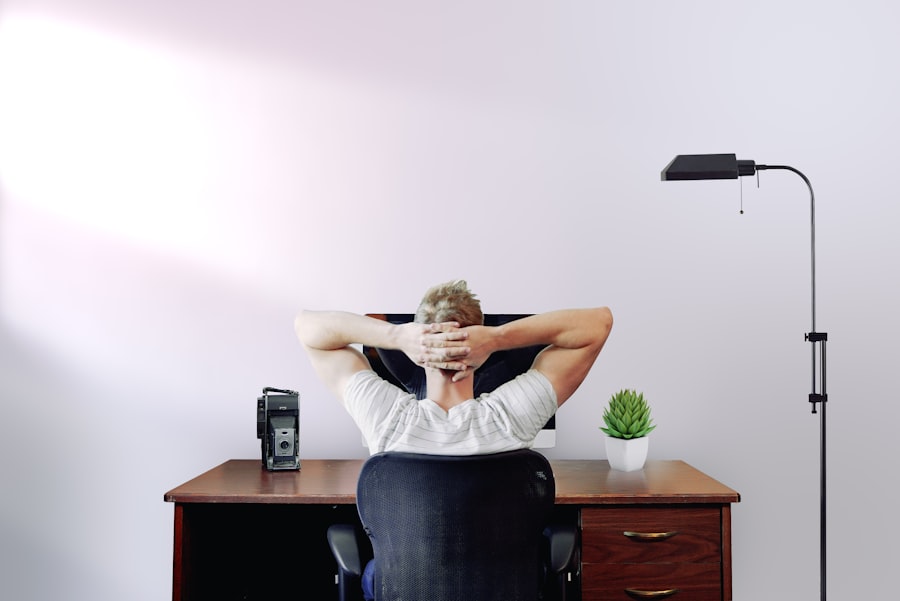Office furniture plays a pivotal role in shaping the work environment, influencing not only the aesthetics of a space but also the productivity and well-being of employees. The right furniture can enhance functionality, promote collaboration, and create a welcoming atmosphere that reflects the company’s brand and values. In contrast, poorly chosen furniture can lead to discomfort, decreased morale, and even health issues among staff.
As such, investing in quality office furniture is not merely a matter of style; it is a strategic decision that can have far-reaching implications for an organization’s success. Moreover, the importance of office furniture extends beyond individual workstations. It encompasses communal areas, meeting rooms, and even reception areas, all of which contribute to the overall experience of employees and visitors alike.
Thoughtfully designed furniture can facilitate communication and teamwork, making it easier for employees to share ideas and collaborate on projects. Additionally, the layout and arrangement of furniture can influence workflow and efficiency, ensuring that employees have the tools they need at their fingertips. In this way, office furniture serves as a foundation upon which a productive and harmonious work environment is built.
Key Takeaways
- Office furniture plays a crucial role in creating a productive and comfortable work environment for employees.
- When choosing office furniture, consider the space available, the needs of the employees, and the overall aesthetic of the office.
- Ergonomics should be a top priority when selecting office furniture to ensure the comfort and well-being of employees.
- Maximize space and functionality by choosing multi-functional furniture and utilizing storage solutions.
- Incorporating style and aesthetics into office furniture can enhance the overall look and feel of the workspace, boosting employee morale and productivity.
Choosing the Right Furniture for Your Office Space
Functional Needs
The nature of the work being performed, the size and layout of the space, and the specific needs of employees all play a significant role in determining the type of furniture required. For instance, an open-plan office may benefit from modular furniture that can be easily reconfigured to accommodate different team sizes or project requirements. On the other hand, a more traditional office setting may call for individual desks and private meeting rooms to foster focused work and confidentiality.
Aesthetic Appeal
In addition to functionality, it is essential to consider the aesthetic appeal of office furniture. The colors, materials, and design elements chosen can significantly impact the overall ambiance of the workspace. For example, bright colors and modern designs may create an energetic atmosphere conducive to creativity, while neutral tones and classic styles may evoke a sense of professionalism and stability.
Striking a Balance
Ultimately, choosing the right furniture involves striking a balance between practicality and visual appeal to create an environment that supports both productivity and employee satisfaction. By understanding the dynamics between functional needs and aesthetic appeal, businesses can make informed decisions that align with both functional needs and employee preferences, leading to a workspace that is both efficient and enjoyable.
Ergonomics and Comfort in Office Furniture

The significance of ergonomics in office furniture cannot be overstated, as it directly affects employee health and productivity. Ergonomically designed furniture promotes proper posture, reduces strain on the body, and minimizes the risk of musculoskeletal disorders. For instance, adjustable chairs that support the natural curve of the spine can help prevent back pain, while desks that accommodate standing or sitting positions allow employees to change their posture throughout the day.
By prioritizing ergonomic principles in furniture selection, employers can foster a healthier work environment that enhances employee well-being. Comfort is another critical aspect of office furniture that influences employee performance. When employees are comfortable in their workspaces, they are more likely to focus on their tasks and engage fully in their responsibilities.
This comfort extends beyond seating; it includes factors such as desk height, keyboard placement, and even lighting conditions. Providing employees with options to customize their workstations according to their preferences can lead to increased job satisfaction and reduced turnover rates. Ultimately, investing in ergonomic and comfortable office furniture is not just a matter of aesthetics; it is an essential component of creating a supportive workplace culture.
Maximizing Space and Functionality with Office Furniture
In today’s fast-paced business environment, maximizing space and functionality is crucial for optimizing productivity. Many organizations face challenges related to limited square footage or the need for flexible work arrangements. To address these challenges, businesses can turn to innovative office furniture solutions that make efficient use of available space.
For example, multi-functional furniture such as desks with built-in storage or conference tables that can be easily collapsed or expanded allows for greater versatility in how spaces are utilized. Additionally, thoughtful layout planning can significantly enhance functionality within an office. By strategically placing furniture to create clear pathways for movement and collaboration zones for teamwork, organizations can foster a more dynamic work environment.
Open spaces can be complemented with privacy screens or acoustic panels to reduce noise distractions while still promoting interaction among team members. Ultimately, maximizing space and functionality through smart furniture choices not only improves workflow but also contributes to a more organized and visually appealing office environment.
Incorporating Style and Aesthetics into Office Furniture
The aesthetic appeal of office furniture plays a vital role in creating an inviting atmosphere that reflects a company’s culture and values. A well-designed workspace can inspire creativity and motivate employees while also leaving a positive impression on clients and visitors. When selecting office furniture, it is essential to consider how different styles—be it modern, minimalist, or traditional—align with the overall branding strategy of the organization.
This alignment helps create a cohesive look that reinforces brand identity throughout the workspace. Moreover, incorporating elements such as artwork, plants, and decorative accessories alongside office furniture can further enhance the visual appeal of the environment. Thoughtful color schemes can evoke specific emotions; for instance, blues may promote calmness while yellows can stimulate energy.
By blending style with functionality, organizations can create spaces that not only serve practical purposes but also foster a sense of belonging and pride among employees. Ultimately, investing in aesthetically pleasing office furniture contributes to a positive workplace culture that encourages engagement and collaboration.
Creating a Collaborative and Productive Work Environment with Office Furniture

Cultivating a Culture of Teamwork and Innovation
Office furniture design has a profound impact on collaboration and productivity within teams. Open-plan layouts equipped with collaborative furniture, such as communal tables or lounge seating, encourage spontaneous interactions among employees, fostering a culture of teamwork and innovation. These spaces allow for informal brainstorming sessions or quick discussions that can lead to creative solutions and enhanced problem-solving capabilities.
Breaking Down Silos and Promoting Cross-Functional Cooperation
By prioritizing collaborative furniture options, organizations can break down silos between departments and promote cross-functional cooperation. In addition to physical arrangements, technology integration into office furniture can further enhance collaboration efforts. Desks equipped with built-in charging stations or conference tables with integrated screens facilitate seamless communication during meetings or group projects.
Fostering Adaptability and Productivity
Furthermore, providing employees with access to mobile furniture that can be easily rearranged allows them to adapt their workspace according to their needs at any given moment. By creating an environment conducive to collaboration through thoughtful furniture choices, organizations can cultivate a productive atmosphere where ideas flourish.
Maintaining and Caring for Office Furniture
Proper maintenance and care for office furniture are essential for ensuring longevity and preserving its aesthetic appeal over time. Regular cleaning routines should be established based on the materials used in the furniture; for instance, wooden surfaces may require polishing while fabric upholstery may need vacuuming or spot cleaning. Additionally, periodic inspections should be conducted to identify any signs of wear or damage early on so that repairs can be made promptly before issues escalate.
Furthermore, educating employees about proper usage practices can significantly extend the lifespan of office furniture. Simple measures such as avoiding excessive weight on desks or using coasters on surfaces can prevent unnecessary wear and tear. Implementing a maintenance schedule that includes professional cleaning services or refurbishing worn-out pieces can also contribute to maintaining an inviting workspace.
Ultimately, investing time in caring for office furniture not only enhances its durability but also reflects an organization’s commitment to providing a quality work environment for its employees.
Budgeting and Investing in Quality Office Furniture
When it comes to outfitting an office space with furniture, budgeting is a critical consideration that requires careful planning. While it may be tempting to opt for cheaper options to save costs initially, investing in quality office furniture often proves more economical in the long run due to its durability and longevity. High-quality pieces tend to withstand daily wear better than their lower-cost counterparts, reducing the need for frequent replacements or repairs.
Therefore, organizations should approach budgeting with a long-term perspective in mind. Additionally, exploring various financing options or bulk purchasing discounts can help organizations maximize their investment in quality office furniture without straining their budgets excessively. It is also beneficial to prioritize essential items first—such as ergonomic chairs or desks—before gradually expanding with additional pieces as resources allow.
By strategically allocating funds toward high-quality office furniture that meets both functional needs and aesthetic preferences, organizations can create an environment that supports employee well-being while enhancing overall productivity.
If you’re in the process of upgrading your office space, you might be interested in exploring the benefits of a height-adjustable desk. These desks are fantastic for ergonomics, allowing you to switch between sitting and standing throughout the day, which can greatly improve your comfort and productivity. For a detailed guide on finding the perfect height-adjustable desk that meets your specific needs, you can read more on this topic by visiting Finding the Perfect Height-Adjustable Desk. This article provides insights into the various features to consider and how to choose a desk that fits well with your office environment.
FAQs
What are the essential furniture items for an office?
Essential furniture items for an office include a desk, chair, filing cabinet, bookshelf, and storage units. Other items such as a conference table, reception desk, and ergonomic accessories may also be necessary depending on the specific needs of the office.
What are the different types of office furniture materials?
Office furniture can be made from various materials including wood, metal, glass, plastic, and composite materials. Each material has its own advantages and can be chosen based on the desired aesthetic, durability, and budget.
How can office furniture be arranged for optimal productivity?
Office furniture should be arranged in a way that promotes a productive and efficient work environment. This can be achieved by considering factors such as natural light, ergonomic positioning of furniture, creating collaborative spaces, and minimizing clutter.
What are some popular trends in office furniture design?
Some popular trends in office furniture design include open-concept workspaces, flexible and modular furniture, ergonomic designs for improved comfort, and the use of sustainable materials. These trends aim to create a modern and adaptable work environment.
How can office furniture contribute to a professional and welcoming atmosphere?
Office furniture plays a significant role in creating a professional and welcoming atmosphere by reflecting the company’s brand, providing comfortable and functional spaces for employees and clients, and maintaining a clean and organized appearance.


